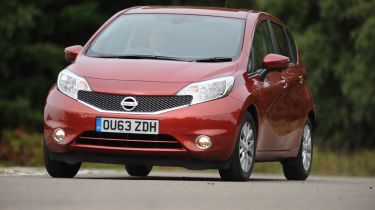Nissan Note (2013-2017) review - Engines, performance and drive
Not the most exciting car to drive, but it's safe and secure, and engines are well proven

The Nissan Note is based on a well-proven platform used by the Renault-Nissan Alliance: dubbed V-platform, it’s also used by the latest Renault Clio. It’s sold in Japan too, but Nissan has fine-tuned the platform here in Britain for European consumption, which means there’s a marked difference between the two – in our favour.
It’s not as fun to drive as the class-leading Ford Fiesta, of course, but it still handles tidily enough, with good body control for a small car that’s slightly taller than the norm. Body lean in corners is kept under control and we also found the steering was well weighted.
The ride can be a little firm as a result though, particularly over pattery surfaces. But it does improve with more than one person in the car, and the integrity of the suspension means it shakes off rough roads better than you might expect.
Engines
Nissan offers just three engines with the Note, two petrol engines and a single 1.5-litre diesel that’s shared with many other models in the Renault-Nissan Alliance. The entry-level 79bhp 1.2-litre is a three-cylinder unit that performs well enough, with a reasonably torquey nature and smooth, free-revving manners.
The petrol engine you really want is the 1.2 DiG-S, a 97bhp supercharged version of the base three-cylinder motor. Introducing tech normally associated with high-performance Jaguars, the supercharger boosts power and, in particular, torque: instead of producing 110Nm, the high-power DiG-S 98 produces 147Nm, which has a significant effect on in-gear flexibility, cutting back on downshifts.
Used - available now

2022 Kia
e-Niro
33,290 milesAutomaticElectric
Cash £20,197
2021 BMW
1 Series
60,610 milesAutomaticPetrol1.5L
Cash £17,697
2014 BMW
1 Series
130,000 milesManualDiesel2.0L
Cash £4,498
2014 Ford
C-Max
39,000 milesManualPetrol1.0L
Cash £4,898Naturally, the supercharged 1.2-litre engine is the fastest Note on sale, although it’s perhaps not as fast as its high-tech nature sounds: it does 0-62mph in 11.8 seconds, instead of the regular car’s 13.7 seconds. An Xtronic CVT automatic version of the DiG-S is also available, which does 0-62mph in 12.6 seconds.
The sole diesel engine is the 1.5 dCi 90, an 89bhp version of the familiar Renault-Nissan four-cylinder turbo diesel motor. This has a big hike in torque again, with 200Nm meaning it produces almost twice the pulling power of the base 1.2-litre petrol, at just 1,750rpm instead of 4,000rpm. For this reason, it’s worth going for diesel if you regularly drive a fully-laden Note.
Performance of the diesel isn’t far behind the DiG-S, either: it does 0-62mph in 11.9 seconds and is just 1mph slower all-out with a top speed of 111mph. It’s worth noting that the diesel is a bit clattery and vocal compared to the petrol engines, though.
Manual gearbox choice is restricted to a five-speed unit. It’s snappy enough and the clutch is reasonably light too – both important considerations in city-based cars. The alternative is that automatic Xtronic CVT gearbox, which is a lot less favourable. In common to all CVT units, its single gear nature doesn’t feel natural and, if you drive quickly, the engine will often be revving loudly. Unless you have to, stick with the manual (and enjoy the significant £1,100 saving).






